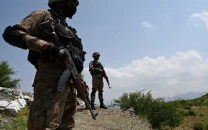Circular debt for dummies

Circular debt for dummies
Other than that, strictly speaking, the phenomenon that is called circular debt is in fact a linear chain of receivables that connects at least four different categories of stakeholders in our power sector. But consider for a moment that none of this is new. For decades the normal state of affairs in our public sector enterprises has been one of delayed payments and disputed amounts.
And our first largescale power crisis took place in 1994, when the gap between electricity supply fell short of peak demand by almost 25 per cent, not far from where it is today. But if we have lived with “circular debt” and an endemic power crisis for all these years, what exactly makes it such a big deal today? The answer lies in a decision made back in 1994, a decision we are told helped lift us out of our power crisis back then.
The decision was called the Private Power Policy of 1994, and in essence it opened the door for the private sector to invest in power generation plants to sell electricity at pre-determined tariffs or rates to the Water and Power Development Authority (Wapda). For a while the policy appeared to work. By the year 2000, almost 16 different private power generation plants had been set up in Pakistan, and came to be known as the Independent Power Producers (IPPs). For a brief moment we became a power surplus country.
But underneath this abundance of electricity, a seismic change had taken place. Most of the electricity in our system ever since that year has been generated from oil, the most expensive fuel for power generation purposes that you can buy. By the year 2000, almost two-thirds of Wapda’s finances were being diverted to pay for this electricity from the IPPs. The new capacity that had lifted us out of the era of shortages was proving to be a devil’s bargain of sorts.
The way out of this rising cost spiral was to shift from fuel to natural gas. That would halve the cost of generation, approximately, and would be a cleaner option anyway. But our gas infrastructure could not keep pace with the speed with which demand was growing. After you have taken our admittedly abundant gas resources and divided them among the numerous claimants (fertiliser, vehicular, residential, industrial), there is precious little left for any other large-scale user. Cutting gas supplies to the fertiliser industry has had the unfortunate consequence of hitting farm incomes and driving up food prices.
(This is politically intolerable in a country where power grows upwards from the soil.) Cutting residential consumers means extinguishing stoves and heaters in urban Punjab. (This is tantamount to political suicide in a country whose raison d’etre is to gratify Punjabi urges.) Cutting ve h i c u l a r Compressed Natural Gas (CNG) supplies means snarled cities and frenzied media coverage of angry car owners. So what’s the path of least resistance when it comes to rationing gas allocations? Cut the power plants. And that brings you back to the cost spiral of oil. In 1994 we thought we had found a way out of the energy crisis by inviting private money into our power sector.
The lure of quick and easy electricity was enough for us. But now it is time to pay the piper. We have come full circle: a large and growing power deficit - just like the one in 1994 - and a growing pile of inter-corporate claims. And that is the only thing circular about this picture.
THE WRITER IS HEAD OF THE BUSINESS DESK AT EXPRESS 24/7 AND EXPRESS NEWS DESIGN: ESSA MALIK



















COMMENTS
Comments are moderated and generally will be posted if they are on-topic and not abusive.
For more information, please see our Comments FAQ